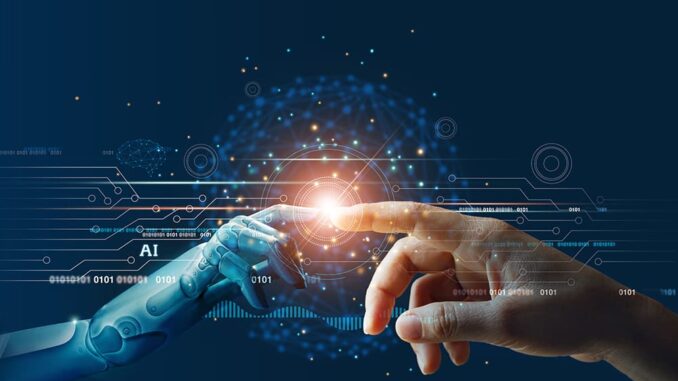
Collaboration between AI and humans, often referred to as “human-AI collaboration” or “augmented intelligence,” is an emerging and vital area in the development of AI technologies.
This concept emphasizes the complementary abilities of both humans and AI systems to create outcomes that neither could achieve alone. Here are some key aspects and benefits of this collaboration:









### 1. **Enhanced Decision-Making**
– **Data Analysis**: AI can analyze vast amounts of data quickly, presenting insights and trends that humans might overlook. This allows professionals to make informed decisions based on real-time data.
– **Scenario Simulation**: AI models can simulate various scenarios, helping humans evaluate potential outcomes before making strategic decisions.
### 2. **Creative Collaboration**
– **Inspiration and Ideation**: AI tools can assist in brainstorming sessions, suggesting ideas for projects, products, or art based on patterns learned from vast datasets.
– **Co-creation Tools**: In fields like design and content creation, AI can serve as a partner, offering design suggestions, drafting text, or generating music, allowing human creators to focus on refining their vision.
### 3. **Operational Efficiency**
– **Automation of Repetitive Tasks**: AI can take over routine and repetitive tasks (e.g., data entry, scheduling), freeing humans to engage in more complex and creative activities.
– **Assistance in Complex Tasks**: In fields like healthcare, AI can assist doctors by providing diagnostic support, analyzing medical images, and managing patient records, enabling them to spend more time on patient interaction and care.
### 4. **Personalized Experiences**
– **Tailored Recommendations**: AI systems can analyze individual preferences and behaviors, providing personalized recommendations in areas like shopping, entertainment, and education.
– **Adaptive Learning**: In education, AI can provide personalized learning experiences, adapting content and pacing to fit the unique needs of each student, while teachers focus on mentorship.
### 5. **Predictive Capabilities**
– **Forecasting and Risk Assessment**: AI can identify patterns in historical data to predict future trends and potential risks, helping professionals in industries like finance, logistics, and disaster management make proactive decisions.
– **Real-Time Feedback**: In dynamic environments, AI systems can provide real-time feedback, helping humans adjust their strategies and actions on the fly.
### 6. **Improved Accessibility**
– **Assistive Technologies**: AI can enhance accessibility for individuals with disabilities. For instance, speech recognition can aid those with mobility challenges, while computer vision can assist the visually impaired.
– **Language Translation**: AI-powered translation tools break down language barriers, enabling effective communication and collaboration across different cultures and languages.
### 7. **Human Oversight and Ethical Alignment**
– **Human-in-the-Loop (HITL) Systems**: Ensuring humans remain involved in the AI decision-making process can improve trust in the system, particularly in high-stakes areas like healthcare and criminal justice.
– **Ethical Monitoring**: Human oversight is critical to ensure AI systems align with ethical principles and societal values, allowing for corrections when AI behavior is questionable or biased.
### 8. **Training and Skills Development**
– **Upskilling Opportunities**: Collaboration with AI can lead to new training paradigms, where individuals learn to work alongside AI, enhancing their skill sets in areas like data literacy, critical thinking, and technology management.
– **Feedback for Improvement**: AI systems can provide constructive feedback and analytics, helping humans refine their skills in various fields, from sports to writing.
### 9. **Safety and Trust**
– **Safety Features**: In safety-critical environments (e.g., automated vehicles, industrial settings), AI can monitor conditions and alert human operators to potential issues before they escalate.
– **Building Trust**: The collaborative approach fosters trust between humans and AI by making systems more transparent and understandable, leading to better acceptance and effective implementation.
### 10. **Interdisciplinary Collaborations**
– **Bridging Knowledge Gaps**: Collaborative efforts across disciplines (e.g., healthcare, engineering, arts) enable more holistic problem-solving by integrating diverse perspectives and expertise facilitated by AI technologies.
– **Civic Engagement**: AI tools can enhance community engagement by analyzing public sentiment and feedback, allowing for more participatory governance and policy-making.
### Challenges in Human-AI Collaboration
While there are numerous benefits to human-AI collaboration, several challenges must be addressed:
– **Bias and Fairness**: Ensuring that AI systems do not reinforce biases and operate fairly across all demographics.
– **Privacy Concerns**: Balancing the need for data with individuals’ rights to privacy and security.
– **Trust Issues**: Building public trust in AI systems given their capabilities and limitations, especially in critical applications.
– **Employment Impacts**: Addressing concerns about job displacement and the need for reskilling as AI systems take over certain tasks.
Overall, effective collaboration between AI and humans has the potential to enhance productivity, creativity, and decision-making across various sectors. As technology continues to advance, fostering this collaboration will be essential to maximizing the benefits of AI while addressing its challenges.

Leave a Reply